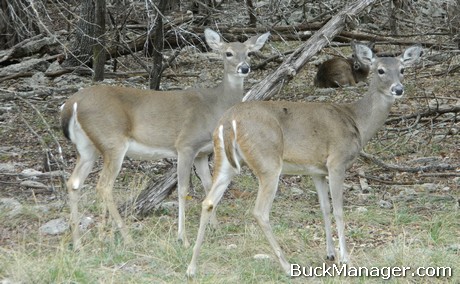The white-tailed deer hunting season is underway and things, at least here in Central Texas, have definitely picked up over the past week. It had been tough hunting with tons of cool season forbs and, believe or not, acorns on the ground! The warmer temperatures did not help the early season deer hunting action either. However, whitetail bucks are now actively seeking out and staying with does. Most of the does observed over the past few days have had anxious bucks right on their heels. The rut is definitely on around here.
Many, but not all, hunters have commented that deer harvest is down in their areas due to an abundance of natural foods. Many places have reported corn just piling up under their feeders. It’s hard to believe that the little bit of rain the region received turned things around so quickly, but that’s very good for the deer. That said, many places involved in deer management programs still have harvest goals they would like to achieve. There is still plenty of hunting season left, so don’t panic yet.

Deer Hunting Small Acreage
A common question asked by hunters on lands located across the white-tailed deer’s range is, “How many does should we shoot?” As one might suspect, there are many variables that will determine the “right” answer to this question. Check out this real life scenario submitted by Brad from Illinois:
“I have a big concern with our family deer hunting property in southern Illinois. We had nine people hunting our 130 acre property during the first week of the shotgun season. During this time, there were only eight whitetail bucks seen, in which two were harvested. During that same time, we observed at least 20 does. We have only harvested one doe in the last 15 years and I’m having a problem with that.
We have six deer food plots on our property that range from about 1/8 to 1/4 acre in size. We also have a three acre lake and a pond. Our property is surrounded by woods and a majority of my family thinks that the hunters around us take out enough does and we do not have to harvest any. We have already had one blue tongue epidemic run through our area about five years ago. I am curious to know what you think about this.”
Tips for Hunting Small Tracts of Land
First, let me just say that nine hunters on 130 acres is a serious amount of deer hunting pressure. However, the important factor is not so much how many hunters are out there, but rather the number of deer on the place and the number of deer that are ultimately harvested. From a habitat management and a deer health standpoint, it is also important to consider how many deer should be out there. How many animals can this 130 acre property support?
When considering small acreage deer management, hunters must consider the reality that deer will move on and off the property at will. Even a doe will have a home range that is several hundred acres in size. Bucks will use larger areas, particularly during the rut. So how many does should you shoot?
There is no simple answer here, especially when the next question to be asked is, “How many do you have?” Deer surveys can help estimate the whitetail deer density in your area and are most beneficial on properties that are smaller than a couple hundred acres in size when neighboring lands are willing pitch in too. Surveys, as well as data from harvested animals, can help answer many questions for you. What percent of does are having fawns each year? Do the body weights of the deer found on my property indicate a healthy herd?
Based on the observations that Brad mentioned above, the buck to doe ratio in his situation is not all that bad, with one buck for every one and half does (at least before two bucks were shot). Some areas can be badly skewed towards females, with as many as five or six or more does per buck, so not bad for Brad. In his situation though, an important, missing component is the number of fawns observed. Fawn production is a good indicator of overall deer herd health.
Small Acreage Deer Hunting and Management
It goes without saying, but I will say it anyway, that trying to manage a deer herd on a small piece of land is difficult, and deer management is sometimes impossible, especially if small neighboring properties are not willing to work together towards a common goal. My recommendations in this situation would be to perform deer surveys prior to the deer hunting season, record deer harvest information such as age, antler and body weights and use habitat condition as a gauge for overall herd health.
Also, contact the state’s department of natural resources. They likely have a local biologist that can visit your property free of charge and offer some insight into the areas deer numbers based on information they have, as well as how whitetail deer are using the habitat found on your property.